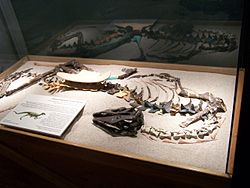- Coeluridae
-
Coelurids
Temporal range: Late Jurassic, 153–150 Ma
Tanycolagreus fossil cast, North American Museum of Ancient Life. Scientific classification 
Kingdom: Animalia Phylum: Chordata Class: Reptilia Superorder: Dinosauria Order: Saurischia Suborder: Theropoda Superfamily: †Tyrannosauroidea Family: †Coeluridae
Marsh, 1881Genera - Coelurus (type)
- Tanycolagreus
Coeluridae is a historically polyphyletic (unnaturally grouped) family of generally small, carnivorous dinosaurs from the late Jurassic Period. For many years, any small Jurassic or Cretaceous theropod that did not belong to one of the more specialized families recognized at the time was classified with the coelurids, creating a confusing array of 'coelurid' theropods that were not closely related. Some dinosaurs mistakenly assigned to Coeluridae in the past include Laevisuchus (a noasaurid) and Microvenator (a close relative of oviraptorids). Although they have been traditionally included in this family, there is no evidence that primitive coelurosaurs like Ornitholestes, Proceratosaurus and Scipionyx form a clade with Coelurus to the exclusion of other traditional coelurosaur families. Other traits that potentially define Coeluridae are uncertain because the genus Coelurus is still incompletely known.
In 2003, O.W.M. Rauhut, using a cladistic analysis, found Coeluridae to include Coelurus (Late Jurassic, North America), Compsognathus (Late Jurassic, Europe), Sinosauropteryx (Early Cretaceous, Asia) and an unnamed Compsognathus-like form (Early Cretaceous, South America; this dinosaur has since been placed in the new genus Mirischia). Rauhut considered coelurids to be a monophyletic group of basal coelurosaurs, characterized by evolutionary reversals in some aspects of the vertebrae to the more primitive theropod condition.[1] However, he and other authors have not since found this result.[2][3][4] Phil Senter proposed in 2007 that Coelurus and Tanycolagreus were the only coelurids, and were actually tyrannosauroids.[4]
References
- ^ Rauhut, Oliver W.M. (2003). "The interrelationships and evolution of basal theropod dinosaurs". Special Papers in Palaeontology 69: 1–213.
- ^ Holtz, Thomas R., Jr.; Molnar, Ralph E.; and Currie, Philip J. (2004). Weishampel, David B.; Dodson, Peter; and Osmólska, Halszka (eds.). ed. The Dinosauria (2nd ed.). Berkeley: University of California Press. pp. 71–110. ISBN 0-520-24209-2.
- ^ Rauhut, Oliver W.M.; and Xu, Xing (2005). "The small theropod dinosaurs Tugulusaurus and Phaedrolosaurus from the Early Cretaceous of Xinjiang, China". Journal of Vertebrate Paleontology 25 (1): 107–118. doi:10.1671/0272-4634(2005)025[0107:TSTDTA]2.0.CO;2.
- ^ a b Senter, Phil (2007). "A new look at the phylogeny of Coelurosauria (Dinosauria, Theropoda)". Journal of Systematic Palaeontology 5 (4): 429–463. doi:10.1017/S1477201907002143.
Categories:- Coelurosaurs
- Theropod stubs
Wikimedia Foundation. 2010.
